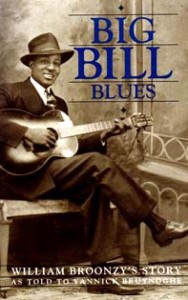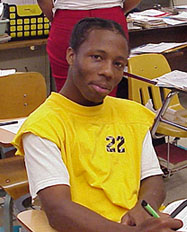Major Works
-
Big Bill Blues 2001
- House Rent Stomp 1999
- I Feel So Good 1998
- Remembering 1990
- 1955 London Sessions 1990
- Big Bill Broonzy In Concert 2002
- Mississippi River Blues 2001
- Legendary Blues Recordings: Big Bill Broonzy 2001
- Essential 2001
- Trouble In Mind 2000
- Post War Years Vol 2:1945-1949 2000
- Absolutely The Best 2000
- Chicago Calling 1999
- Warm Witty & Wise 1998
- Treat Me Right 1996
- Big Bill’s Blues 1996
- Just A Dream 1995
- I Feel So Good 1995
- Black Brown & White 1995
- Baby Please Don’t Go 1994
- Vol. 4-(1935-36) 1992
- 1935-47 1991
- Bill Broonzy Story 1960
- Historic Concert Recordings 1957
- Sings Folk Songs 1956
- 1955 London Sessions 1955
- Good Time Tonight 1930
- Young Big Bill Broonzy 1928-35 1928
- Do That Guitar Rag 1928-35 1928
William Lee Conley Broonzy: A Biography
By Anton Duck (SHS)
William Lee Conley Broonzy, one of the masters of country blues, was born in Scott, Mississippi, on June 26, 1893. However, one source says Broonzy had a twin sister name Lannie Broonzy, who says she has proof that she was born in 1898, on June 26. This information would have proved that Broonzy was five years younger than he pretended. Big Bill was the son of Frank Broonzy and Mittie Belcher, who had seventeen other children (Bruynoghe 9). During this time period, many black men added years to their age either to get a job or join the military, so the exact date of Broonzy’s birth is not clear (Barnwell 317).
Broonzy’s life as a child was hard because he received only minimal schooling. He had to quit school to help his sharecropping family around the house. Before he moved to Arkansas, Broonzy learned how to play the fiddle from his uncle Jerry Belcher. At the age of fourteen, he started working for tips at country dances, picnics, and he played for the church (Broonzy). During the years 1912-1917, Broonzy worked part time as a preacher and violinist.
Then Broonzy served in the US Army during World War I. After his discharge, he returned back to Arkansas. This is the time when he decided that farming was not what he wanted to do for the rest of his life. He wanted to make his living as a guitar player and singer. In 1924, Broonzy moved to Chicago to start his music career partly because of all the racism that was happening in the South. Under the guidance of Papa Charlie Jackson, Broonzy learned how to play the guitar. In the 1930’s Broonzy became known as one of the major artists on the Chicago Blues scene. During this time he performed with other top blues artist in Chicago– like Memphis Minnie, Tampa Red, Jazz Gillum, Lonnie Johnson, and John Lee “Sonny Boy” Williamson. Also, while trying to make it in the music business, he worked as a janitor and maintenance man (Big Bill Broonzy).
In 1938 Broonzy performed at John Hammond’s famous Spiritual and Swing concert at Carnegie Hall in New York City. This was the first time that he had ever performed in front of a white audience. After the concert, people started calling him “Big Bill” Broonzy. At this time Broonzy received newfound fame as the father of Chicago blues.(Broonzy). He was one of the best known blues players and recorded over 260 blues songs including Feelin’ Low Down, Remember Big Bill, Make Me Getaway, and Big Bill Broonzy Sings Country Blues (Brewer 15). His recording career spanned five long decades as he traveled from Mississippi to Chicago and even to Europe, where he became well-known. There are forty-two of his albums still available (Cox 113).
After the arrival of artists like Muddy Waters and the playing of the electric guitar, Broonzy’s brand of blues was pushed aside. Rather than retire, he changed his style of music to folk blues. In 1951, Broonzy toured Europe where he performed standard blues, traditional folk tunes, and spirituals to appreciative audiences. The following year Broonzy returned to Europe with pianist Blind John Davis. He opened the doors for other American blues artists to tour there as well. In 1955, with the help of writer Yannick Bruynoghe, he told the story of his life in the book Big Bill Broonzy. This book was originally published in London. Big Bill Broonzy’s book was one of the first autobiographies by a blues man (Big Bill Broonzy). In 1957, William Lee Conley Broonzy was diagnosed with throat cancer. He continued to perform, although he had with great pain, until he died of throat cancer on August 15, 1958. In 1980, he was inducted into the Blues Foundation’s Hall of Fame (Cox 113).
Timeline
- 1893 Born in Scott, Mississippi, on June 26
- 1899 learned how to play the fiddle
- 1905 Started playing for the church, picnics, country dances
- moved to Arkansas
- 1912-1917 Worked as a preacher and violinist
- 1918-1919 served in US Army
- 1924 moved to Chicago, IL
- 1930’s Major artist on the Chicago blues scene
- worked as janitor and maintenance
- 1938 performed at John Hammond’s Spirituals and Swing Concert
- 1939 Song at Carnegie Hall in New York City
- Wrote a book called Get Back
- 1951 toured in Europe
- 1955 wrote a book call Big Bill’s Blues
- 1956 diagnosed with throat cancer
- 1958 Died August 15, Chicago, IL
- 1980 Inducted into Blues Foundation’s Hall of Fame
- 1992 his autobiography was published
Related Websites
- Biography of Big Bill Broonzy. Encyclopedia of Arkansas History & Culture
- Website dedicated to Big Bill Broonzy
- Big Bill Broonzy: History’s Musical Chameleon. NPR Music
Bibliography
- Barnwell, Marion. A Place called Mississippi: Collected Narratives. Jackson:University Press of Mississippi, 1997. 317-321
- Brewer, James H. Ed. Mississippi Musicians Hall of Fame: Legendary Musicians Whose Art Has Changed the World. Brandon, Ms : Quail Ridge Press, 2001. 15
- Bruynoghe, Yannick. Big Bill Blues: William Broonzy’s Story . New York : Da Capo Press, 1995. 9-10.
- Cox, James L. Mississippi Almanac 1997-1998 : The Ultimate Reference on the State . Yahoo City : Computer Search and Research, 1997. 113.


